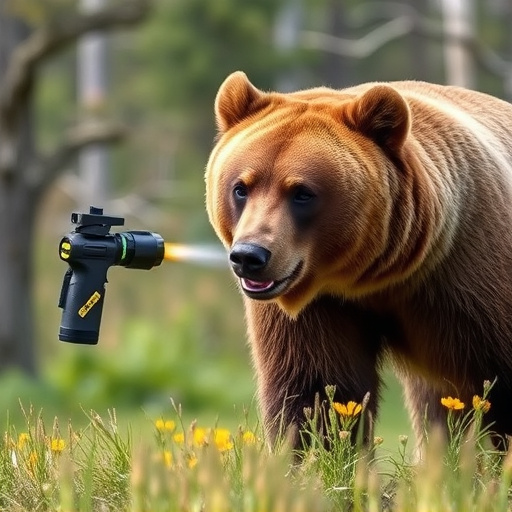Alaska's regulations on bear spray usage prioritize public safety and environmental preservation, with a growing emphasis on biodegradable alternatives. Traditional sprays can contain harmful components that pollute water bodies and impact wildlife, but biodegradable bear spray breaks down naturally, reducing ecological disruption. Proper disposal methods guided by regulations prevent pollution from used cans. By choosing biodegradable products, outdoor enthusiasts minimize their environmental impact while enjoying Alaska's wilderness responsibly and promoting coexistence with bears in sensitive habitats.
Alaska, with its diverse wildlife, requires responsible handling of bear spray. This article explores the intricate balance between human safety and environmental conservation through a lens of biodegradable bear spray. We delve into Alaska’s strict regulations and their ecological implications, contrasting them with conventional sprays. Understanding the unique fog pattern design promotes effective usage while minimizing harm to wildlife and ecosystems, highlighting the growing trend towards eco-friendly solutions in outdoor gear.
- Understanding Alaska's Bear Spray Regulations and Their Environmental Implications
- The Biodegradable Alternative: How It Differs and Its Benefits for Wildlife and Ecosystems
- Effective Fog Pattern Design: Ensuring Safety Without Harming Nature's Delicate Balance
Understanding Alaska's Bear Spray Regulations and Their Environmental Implications
In Alaska, the use and handling of bear spray are subject to specific regulations designed to balance public safety with environmental preservation. Understanding these rules is crucial for outdoor enthusiasts and residents alike, especially when considering the state’s unique ecosystem. One key aspect is the push towards biodegradable bear spray, which minimizes the ecological impact of its application. Traditional bear sprays often contain non-biodegradable components that can persist in the environment, potentially harming wildlife and water bodies. Biodegradable alternatives offer a more sustainable solution without compromising effectiveness.
The environmental implications extend beyond the spray itself. Proper disposal methods are essential to prevent pollution. Regulations guide how used bear spray cans should be disposed of or recycled, ensuring they don’t end up in natural habitats where they can pose risks to animals and plants. By adhering to these guidelines and choosing biodegradable products when possible, Alaskans and visitors can responsibly enjoy the state’s wilderness while preserving its delicate balance.
The Biodegradable Alternative: How It Differs and Its Benefits for Wildlife and Ecosystems
The growing concern for environmental preservation has led to innovations in bear spray technology, with a significant focus on biodegradable alternatives. Traditional bear sprays often contain harsh chemicals that can have detrimental effects on ecosystems and wildlife when not used properly or disposed of after use. In contrast, biodegradable bear spray offers a more environmentally friendly option.
This alternative is designed to break down naturally over time, reducing pollution and minimizing the risk of harm to non-target species. Its composition typically includes natural ingredients and organic solvents, ensuring minimal ecological impact. By choosing biodegradable options, outdoor enthusiasts contribute to the conservation of sensitive habitats and the well-being of local wildlife populations. This shift towards eco-conscious products is a positive step in promoting responsible recreation and coexistence with bears in Alaska’s diverse landscapes.
Effective Fog Pattern Design: Ensuring Safety Without Harming Nature's Delicate Balance
The design of a bear spray fog pattern plays a pivotal role in its effectiveness and environmental impact. A well-thought-out fog pattern aims to protect both individuals and Alaska’s unique ecosystem without causing harm. It’s crucial to strike a balance between ensuring safety and preserving nature’s delicate tapestry.
In the case of biodegradable bear spray, the focus shifts towards minimizing ecological disruption. Traditional sprays often leave behind harmful residues, but eco-friendly alternatives break down naturally within weeks. This not only reduces long-term environmental damage but also guarantees that wildlife interactions remain safe and undisturbed, fostering a harmonious coexistence between humans and Alaska’s majestic bears.
In conclusion, navigating Alaska’s bear spray regulations requires a delicate balance between human safety and environmental preservation. The shift towards biodegradable bear spray offers a promising solution by minimizing ecological harm while maintaining effective protection. By understanding the unique fog pattern design and its positive implications for wildlife and ecosystems, we can ensure that our interactions with nature remain safe and sustainable. Embracing these innovative alternatives is crucial in preserving Alaska’s vibrant tapestry for future generations.
